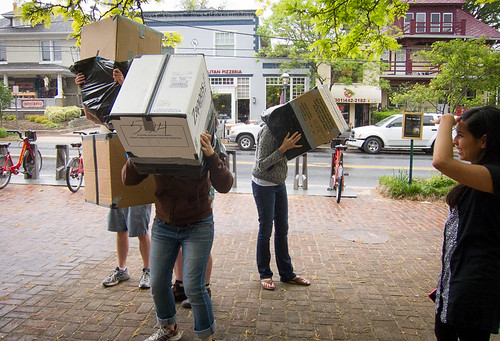Class Report
Make a Camera Obscura

Teacher: Diana Sanchez, photographer (far right)
Documentarians: Heidi Zheng, text; Dave Ramos, photos
Location: Takoma Park NatureLab
Date: May 10, 2014
See more photos of this class on Flickr!
What it is:
A camera obscura is an optical device that projects an inverted image of its surroundings onto a surface. In Latin, the term means “darkened room.”
To fashion a camera obscura like the ones pictured above, simply poke a small hole on one side of a cardboard box, at a level slightly higher than your eyes. This enables the light to cast an upside-down image onto the wall of the box opposite the pinhole.
Seal the rest of box’s interior with a black trash bag to minimize any unwanted light from leaking in, which would dilute the image. The bag should cover your neck and hit your shoulders.
Once inside the box, your head should face the wall opposite of the hole, so you can see the scenery behind you.
The brighter it is outside, the sharper the images are. So it’s best to try out your camera obscura on a sunny day.
With enough trash bags or other dark-colored material, you can convert an entire room into one giant camera obscura.
How it works:
Most of the light entering the pinhole comes in at an angle. Rays from above the hole will hit the bottom of the camera’s back wall, and vice versa. (Light entering from directly in front of the pinhole hits the middle.) That’s why the image is inverted. In short, a camera obscura functions like a black-and-white, upside-down, rear-view mirror.
This mechanism is the same as that of fancier cameras and the human eye. So why don’t you see things upside down? Your brain is rotating the image data sent by your eyes. A digital camera rotates the image for you. In an SLR camera, images aren’t upside down when you look through the viewfinder because a prism (or some mirrors) flips them.
Resources:
Check out the work by Abelardo Morell, an artist who works with camera obscuras. The Smithsonian’s American Art Museum owns some of his work, so hopefully they will display it in the near future.
Read about the history of the camera obscura here.
This is a great podcast if you’re interested in the history of photography.
Heidi Zheng is a student at the University of Rochester, where she majors in religious studies and prepares for her certificate in literary translation. A woman of letters in the making, she is utterly smitten with words, and kittens. And mittens. But mostly, words.
